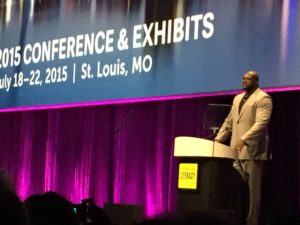 Last month, I attended the 2015 ILA Conference, held this year in St. Louis, MO. Instead of flying out and back, as I normally would, I decided it would be fun to road trip with the family. A road trip, mind you, is different from merely travelling: One doesn’t just arrive and depart; one journeys. And as with all journeys, I returned home tired, grateful, and changed.
Last month, I attended the 2015 ILA Conference, held this year in St. Louis, MO. Instead of flying out and back, as I normally would, I decided it would be fun to road trip with the family. A road trip, mind you, is different from merely travelling: One doesn’t just arrive and depart; one journeys. And as with all journeys, I returned home tired, grateful, and changed.
At the conference, we had the honor of listening to Shiza Shahid, one of the keynote speakers at the first general session. Her story was amazing: She grew up in a middle-class Pakistani family and got a good education, enough to win a scholarship to Stanford. One summer while at Stanford, she flew back to Pakistan to organize and run a summer camp for girls, teaching them to be self-empowered. Malala Yousafzai was an attendee. A couple years later, after Shiza had landed a consulting job in Dubai, she got the devastating news: Malala had been shot. She returned to Pakistan and became the CEO and co-founder of the Malala Fund.

It was an incredible story, and the 6000 educators in attendance were stunned. Shiza continued her speech with a plea for girls’ education around the world, quoting statistics about how educating girls benefits an entire country both socially and economically. “Education is the great equalizer,” she said, citing her own life as proof.

This certainly was true for Shaq—I mean, Dr. O’Neal—who spoke next. After his time in the NBA, he fulfilled his mother’s longtime wish of him finishing his bachelor’s degree. But it still wasn’t enough: Even though he was a spokesperson for several companies, at corporate meetings the company reps often would not address him, preferring instead to speak to his lawyer—they didn’t think he would understand the complex details of business dealings. As a result, he returned to school to get an MBA. “Now you talk to me,” he told the reps after. “I learned how to speak their language,” he explained, so he could have a voice at the table. Shaq would go on to earn his Ed.D.
I found the pairing of these two speakers to be remarkable. On one hand, Shiza fights for the most basic of rights: the right of a person to be educated. On the other, Shaq comes from a culture that in many ways takes education for granted while simultaneously perpetuating its own educational inequalities. Shaq had the dream of many low-income kids: to play professional sports. But his parents knew better, always asking him, “What will you do after?”
On the way home from St. Louis, we stopped at the Flight 93 National Memorial near Shanksville, PA. It is a quiet and profound place; indeed it is sacred. Later (since biographies of the hijackers have no place at the site), I found out that the principal hijacker of Flight 93 came from a wealthy home and was very educated, attending a university in Germany. This saddens me, because I want to believe that education itself can be a panacea to the world’s problems. As an English teacher, I mistakenly believe that people couldn’t possibly study something like the Iliad and not become better human beings. But of course this is not true. Education opens the door for understanding, compassion, and broad-mindedness, but it is ultimately the individual that must pass through it. Illiteracy is a socio-economic issue, but morality is not.
It is possible, of course, for education to embody ethics: Shaq described the moment one of his teachers in grade school pulled him aside when it was clear he was headed down the wrong path, the path of apathetic trouble-making so many of friends had already embraced. “You have a choice,” she told him. It was a teacher, he said, who changed the course of his life.
As teachers, we are in a unique position to offer an education and ethical guidance. Both are needed in today’s world. We have the power to help students evolve as people—not by instilling our own religious (or not) beliefs on them, but by nudging them toward deeper, more complex, more challenging thinking about what it means to be human.

The picture here is part of the memorial in Shanksville. The field where the crash happened is secured with a low, black granite wall and a solemn path dotted with benches. At the end of the wall, there is a higher white marble wall, and a corner. Around the corner is this gate. When you look through it, you gaze directly at the point of impact. The gate itself is made of hickory wood, the type of tree at the edge of the field. Much of the plane’s debris was found in this hickory grove. The gate symbolizes the passage through, the opening into, the crossing over. The passengers on Flight 93 had taken a vote and chosen to dedicate their lives to this sudden, terrifying act of defiance and survival. The choice itself was an opening, a crossing over, from fear to action.
We must push students to look at the world deeply, to ask themselves what they stand for. We must give them not only the tools of a good education, but the tools for ethical, responsible action. The tools to uplift others. The tools to overcome fear. These were the messages of Shiza, Shaq, and Shanksville. At the memorial, I could not shake Mary Oliver’s moving ending to “The Summer Day”:
Doesn’t everything die at last, and too soon?
Tell me, what is it you plan to do
with your one wild and precious life?
It is a question we must ask ourselves, and our students.

Leave a Reply